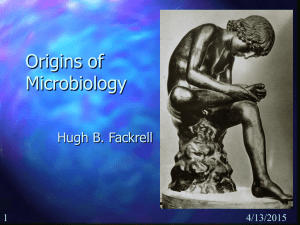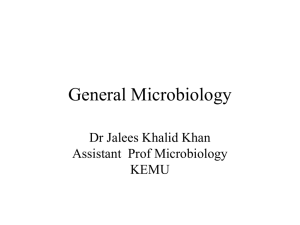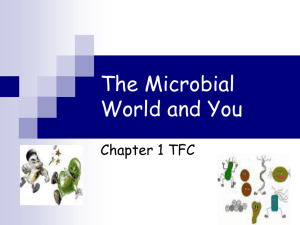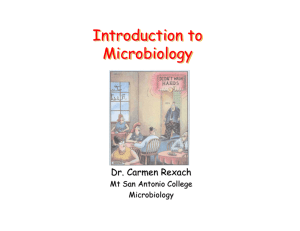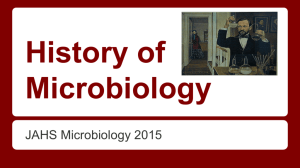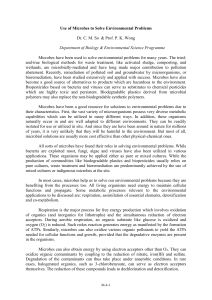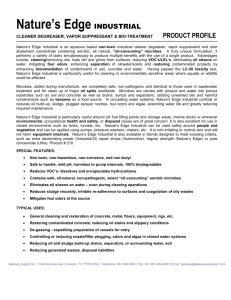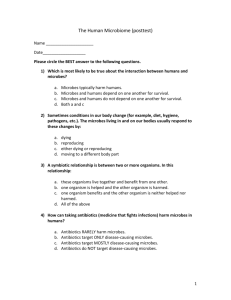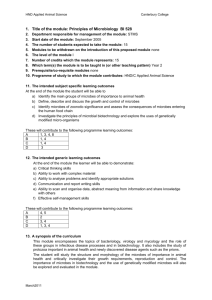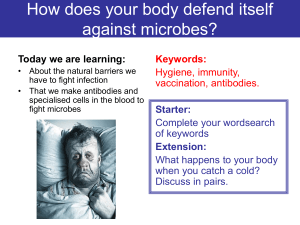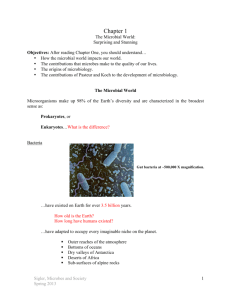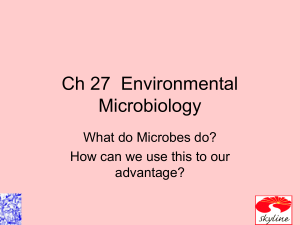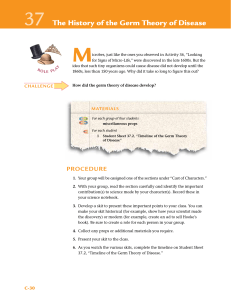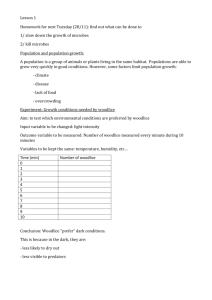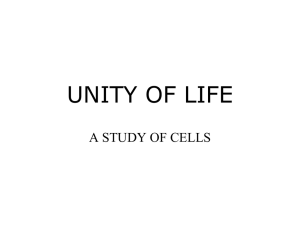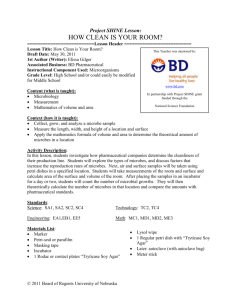All organisms are made up of cells.
advertisement
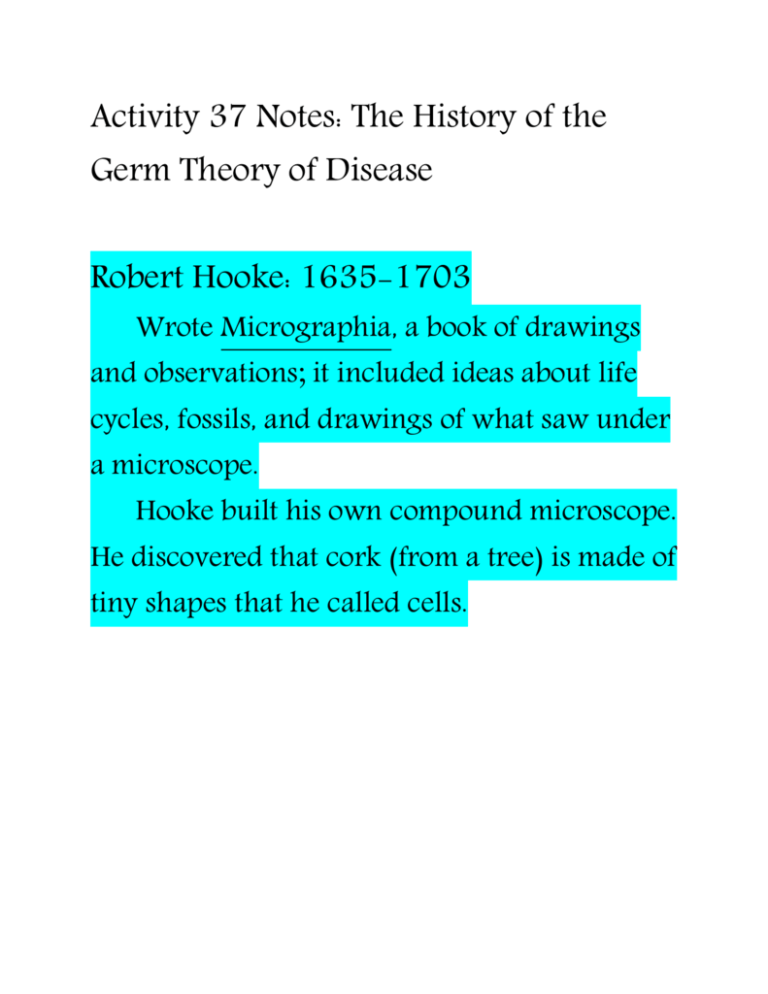
Activity 37 Notes: The History of the Germ Theory of Disease Robert Hooke: 1635-1703 Wrote Micrographia, a book of drawings and observations; it included ideas about life cycles, fossils, and drawings of what saw under a microscope. Hooke built his own compound microscope. He discovered that cork (from a tree) is made of tiny shapes that he called cells. Anton van Leeuwenhoek (1632-1723) Made simple microscopes that could magnify objects up to 200x. Leeuwenhoek made very detailed observations about pondwater and tooth scrapings. He was one of the first to observe microbes, which he called animalcules. Mattias Jakob Schleiden (1804-1881) Theodor Schwann (1810-1882) Karl Theodor Ernst von Siebold (18041885) Schleiden was a botanist (studied plants) who used microscopes to study plants (at a time when most botanists looked only at whole plants); he suggested that all plants are entirely made of cells. Schwann suggested that all animals are entirely made of cells. Schleiden and Schwann get credit for Cell Theory: All organisms are made up of cells. Von Siebold suggested microbes are also made up of cells ~ (usually one cell each). Rudolf Carl Virchow (1821- 1902) * Virchow said, in the 1850s “all cells arise from cells,” meaning cells reproduced to create new cells. * All organisms begin as a single cell. * Most microbes are made of ONLY one cell. * An adult human is made of about 10 trillion cells. * Virchow thought diseases were caused by cells not working properly. This is true for some diseases (such as leukemia), but not all. Ignaz Philipp Semmelweiss (18181865) * Semmelweiss was worried about “childbed fever,” which killed a lot of women. He noticed that many doctors examined pregnant women right after doing autopsies. * Semmelweiss tried washing his hands between patients: his death rate dropped from 12% to 1%. * Semmelweiss tried to get hospitals/doctors to change habits (i.e. wash hands), but people resisted because he couldn’t explain why washing hands saved lives. Louis Pasteur (1822-1895) * Pasteur discovered that some microbes caused food and drink to spoil, and that heat can kill a lot of those microbes (such as tuberculosis); using heat to kill microbes is now called “pasteurization.” * Pasteur thought microbes caused some infectious diseases; this idea is the basis of the Germ Theory of Disease. Robert Koch (1843-1910) * Koch found scientific evidence that specific microbes caused specific diseases; he identified anthrax, tuberculosis, and cholera. * Koch injected healthy mice with anthrax, then injected another group of healthy mice with blood from the infected mice, and observed. All infected mice died, and anthrax microbes were found only in infected mice, not in healthy ones. * Koch developed agar, a gelatin-like substance, to culture (grow) bacteria. Florence Nightingale (1820-1910) * Nightingale believed that cleanliness was part of good nursing, and she PUBLISHED her ideas in 1860. * Her ideas improved sanitation at military hospitals and saved many soldiers’ lives. Joseph Lister (1827-1912) * Lister heard about Pasteur’s Germ Theory of Disease, and decided to use chemical antiseptic to clean surgical instruments. He also sprayed the air, and required hand washing and clean aprons. * After making these changes, the death rate of patients after surgery dropped from 45% to 15%. William Stewart Halsted (1852-1922) * Halstead took germ theory to the next practical level: he prevented the spread of germs by wearing rubber gloves during surgery (gloves are easier to sterilize than hands). The Theory of Spontaneous Generation * Once upon a time, many scientists believed that living things grew from non- living things (e.g. plants grow from soil, no seeds; maggots grow from meat, no eggs needed). It took lots of experiments to prove Virchow right: in fact, cells arise from cells (not from dirt or meat). * 3 Major Experiments * In 1668, an Italian doctor named Francesco Redi did an experiment to prove that maggots grew from eggs laid by flies (not from meat). He set up jars of meat, some uncovered, some sealed, some covered with gauze: maggots only grew in the open jars, where flies could reach the meat. * In 1767 an Italian priest (Spallanzini) sealed and boiled bottles of liquid: nothing grew in the bottles. In 1859, Pasteur did a similar experiment with fancy flasks and yeast cells. Both experiments showed that microbes can only grow from other microbes: organisms cannot come from non-living things.

